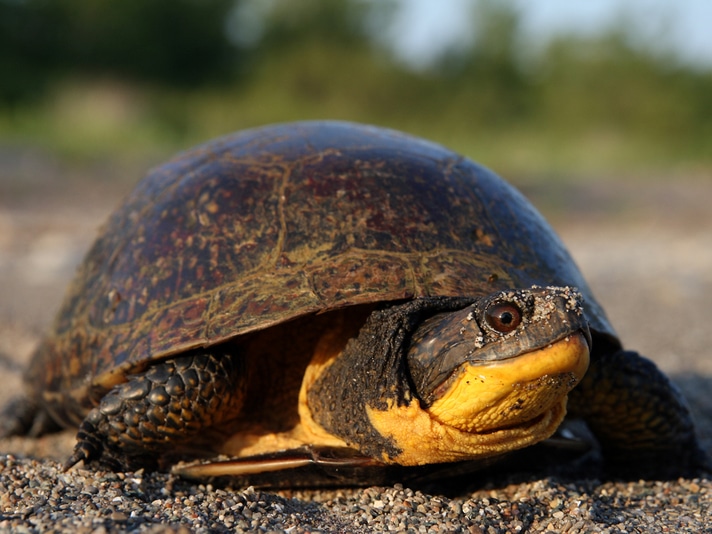Description:
Blanding’s turtles like a roomy cage. Hatchlings can be housed in a 15-gallon tank with a land area. They also enjoy real or artificial plants in the water area. Adult turtles require a much larger enclosure; I recommend a large Waterland tub, which are available at quality reptile stores and online. Indoor housing for both large and small specimens should include a land area with a hot spot of about 95 degrees Fahrenheit, provided by a heat lamp or heat emitter. Suspend or place a tube-style UVB lamp over the open enclosure (not on top of a glass top, which would filter out the UVB). For baby Blanding’s, keep the water shallow to ensure they don’t run into a problem and drown. Add real or artificial plants, cork flats and other interesting things for them to rest on and play around with in the water. A hide on the land section is also a good touch. For outdoors, the same set up. You may or may not need to add a heat emitter to garner the desired hot spot, depending on where you live. Do not use aquariums as outdoor turtle enclosures for any reason, especially for babies. Heat builds up quickly and death is the result. Waterland tubs, again, are perfect for housing turtles outdoors. Blanding’s turtles do brumate if the temps drop. Once again, depending on where you live, you may need to bring the turtles inside for the winter, and place them in a cool area (such as a garage) in a Rubbermaid container containing leaves or shredded paper. You don’t need to brumate them and can give them an endless summer, if desired. A good water filtration system is needed to keep enclosure water fresh and clear. Water quality is always very important. Blanding’s turtles will typically eat earthworms, chopped fish and commercial turtle food. Remember to always remove uneaten food to keep the water clear.. Blanding’s turtles are protected throughout most of their range. Adults are difficult to find. However, captive breeding is becoming increasingly successful and common, and you can often find captive-bred babies at reptile shows, on the Internet and in select reptile stores. Ken Foose produced his first captive-bred snakes at age 11. With a Master’s Degree in zoology, he has been both a zookeeper and curator. He opened Exotic Pets, which specializes in reptiles and amphibians, in Las Vegas in 1991. He is currently president of the International Herpetological Symposium.
Habitat:
Open ponds and swampy areas, debris-covered sites near wooded habitat
Range:
Centered around the Great Lakes, and extends from central Nebraska and Minnesota eastward through southern Ontario and the south shore of Lake Erie as far east as northern New York, with a few disjunct populations in southeastern New York (Dutchess County), New England and Nova Scotia
Scientific Name: Emydoidea blandingii
Species Group: turtle
Family: Emydidae
Size: Medium
Level: advanced
Weight: N/A
Dangerous: No



